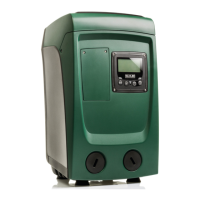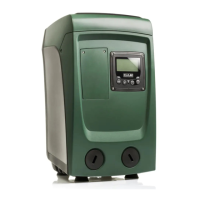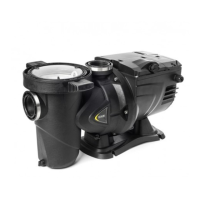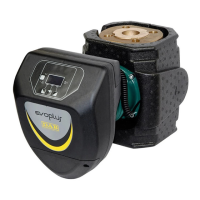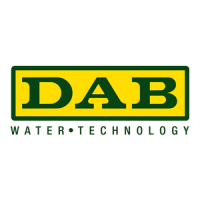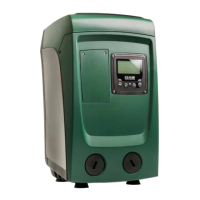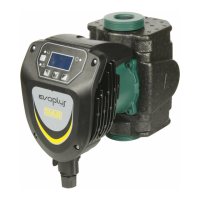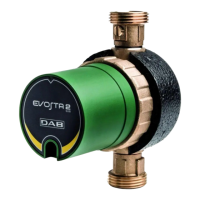ENGLISH
GB
94
When the ET of a device has elapsed the system starting order is reas-
signed so as to give minimum priority to the device on which the time
has elapsed. The aim of this strategy is to use less the device that has
already worked and to balance the working time between the various
machines that make up the set. If the hydraulic load still requires the in-
tervention of the device, even though it has been put last in starting order,
it will start to guarantee pressure boosting of the system.
The starting priority is reassigned in two conditions based on the ET time:
1. Exchange during pumping: when the pump remains on without
interruption until the absolute maximum pumping time has been
exceeded
2. ([FKDQJHWRVWDQGE\ZKHQWKHSXPSLVRQVWDQGE\EXWRIWKH
ET time has been exceeded
If ET has been set at 0 there will be exchange to standby. Whenever
DSXPSLQWKHVHWVWRSVDGLIIHUHQWSXPSZLOOVWDUW¿UVWQH[WWLPHLWLV
restarted.
If the parameter ET (maximum work time) is set at 0, there will
be exchange at each restart, irrespective of the pump’s actual
work time.
7.7.5 - AY: Anti Cycling
As described in paragraph 9, this function is for avoiding frequent switch-
ing on and off in the case of leaks in the system. The function can be
enabled in 2 different modes, normal and smart. In normal mode the elec-
tronic control blocks the motor after N identical start/stop cycles. In smart
mode it acts on the parameter RP to reduce the negative effects due to
leaks. If set on “Disable”, the function does not intervene.
7.7.6 - AE: Enabling the anti-block function
This function is for avoiding mechanical blocks in the case of long inactiv-
ity; it acts by periodically rotating the pump.
When the function is enabled, every 23 hours the pump performs an
unblocking cycle lasting 1 min.
([DPSOHVRIFRQ¿JXUDWLRQIRUPXOWLSXPSV\VWHPV
Example 1:
A pump set composed of 2 devices (N=2 detected automatically) of which
1 set active (NA=1), one simultaneous (NC=1 or NC=NA since NA=1) and
one as reserve (IC=reserve on one of the two devices).
7KHUHVXOWREWDLQHGLVWKHIROORZLQJWKHGHYLFHQRWFRQ¿JXUHGDVDUH-
serve will start and work by itself (even though it does not manage to bear
the hydraulic load and the pressure achieved is too low). If it has a fault,
the reserve device steps in.
Example 2:
A pump set composed of 2 devices (N=2 detected automatically) in which
all the devices are active and simultaneous (factory settings NA=N and
NC=NA) and one as reserve (IC=reserve on one of the two devices).
7KHUHVXOWREWDLQHGLVWKHIROORZLQJWKHGHYLFHWKDWLVQRWFRQ¿JXUHG
DVUHVHUYHDOZD\VVWDUWV¿UVWLIWKHSUHVVXUHGHWHFWHGLVWRRORZWKH
VHFRQGGHYLFHFRQ¿JXUHGDVUHVHUYHDOVRVWDUWV,QWKLVZD\ZHDOZD\V
WU\WRSUHVHUYHWKHXVHRIRQHGHYLFHLQSDUWLFXODUWKHRQHFRQ¿JXUHG
as reserve), but this may be useful in case of necessity when a greater
hydraulic load occurs.
Example 3:
A pump set composed of 4 devices (N=4 detected automatically) of which
3 set active (NA=3), 2 simultaneous (NC=2) and 1 as reserve (IC=reserve
on two devices),
The result obtained is the following: at the most 2 devices will start at the
same time. The operation of the 2 that can work simultaneously will take
place in rotation among 3 devices so as to respect the maximum work
time of each ET. If one of the active devices develops a fault no reserve
starts up because more than 2 devices cannot start at one time (NC=2)
and there are still 2 active devices present. The reserve intervenes as
soon as another of the 2 develops a fault.
7.7.4 - ET: Exchange time
Sets the maximum continuous working time of a device in a set. It is
VLJQL¿FDQWRQO\RQSXPSVHWVZLWKLQWHUFRQQHFWHGGHYLFHV7KHWLPHFDQ
be set between 1 min and 9 hours; the factory setting is 2 hours.
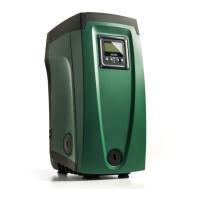
